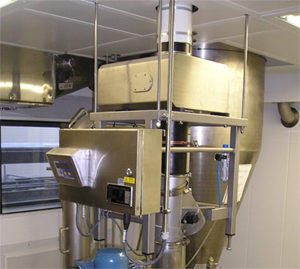 A. Lock Inspection Systems have been awarded ATEX approval for Zone 21 and 22 following a comprehensive and auditing process from an approval notified testing body. Lock is the first UK metal detection manufacturer to comply with the new directive on explosion protection.
A. Lock Inspection Systems have been awarded ATEX approval for Zone 21 and 22 following a comprehensive and auditing process from an approval notified testing body. Lock is the first UK metal detection manufacturer to comply with the new directive on explosion protection.
Food Pharmaceutical, Bakery and Snack manufacturers are facing mounting pressure to comply with the regulations, now they can turn to Lock for inspection solutions of all incoming bulk raw materials in granular and fine powder form.Potentionally explosive conditions are common in many areas of the food and pharmaceutical production plants where airbourne dust from materials such as flour, cocoa, rice, grains and powders can create environments which could become explosive.
Hitesh Hirani, Technical Director of Lock Inspection System comments, “Compliance with international performance and In 2003, two European directives came into force concerning ATEX legislation. Directive 94/9/EC is concerned with equipment and protective systems intended for use in potentionally explosive atmospheres, while the second, 99/92/EC is concerned with the health and safety of workers potentially at risk for exposure to explosive atmospheres.
safety standards is a priority of Lock. More and more manufacturers are required to confirm to ATEX regulations to demonstrate due diligience and to secure themselves against explosion risks. By investing significant funds and resources into this certification, Lock can assist the customer to meet the required standards.”
A risk assessment is the first step needed to determine whether ATEX compliance is required. This establishes whether there are any dusk risk areas within the plant and then classifies these areas into Zones according to the level of risk. Zone 20 represents a continuous risk, Zone 21 occassional risk and Zone 22 minimal risk of explosion.
Hazardous places are classified in terms of zones on the basis of the frequency and duration of the occurrence of an explosive atmosphere.
Gases, vapours and mists
For gases, vapours and mists the zone classifications are:
- Zone 0: A place in which an explosive atmosphere consisting of a mixture with air of dangerous substances in the form of gas, vapour or mist is present continuously or for long periods or frequently.
- Zone 1: A place in which an explosive atmosphere consisting of a mixture with air of dangerous substances in the form of gas, vapour or mist is likely to occur in normal operation occasionally.
- Zone 2: A place in which an explosive atmosphere consisting of a mixture with air of dangerous substances in the form of gas, vapour or mist is not likely to occur in normal operation but, if it does occur, will persist for a short period only.
Dusts
For dusts the zone classifications are:
- Zone 20: A place in which an explosive atmosphere in the form of a cloud of combustible dust in air is present continuously, or for long periods or frequently.
- Zone 21: A place in which an explosive atmosphere in the form of a cloud of combustible dust in air is likely to occur in normal operation occasionally.
- Zone 22: A place in which an explosive atmosphere in the form of a cloud of combustible dust in air is not likely to occur in normal operation but, if it does occur, will persist for a short period only.
 Download Brochure
Download Brochure